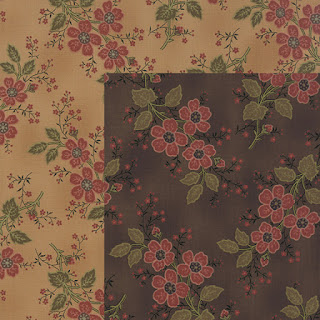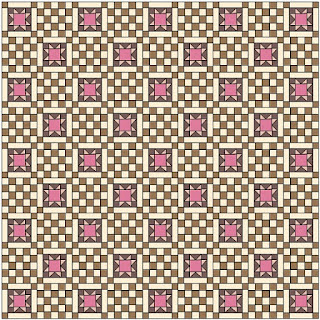Becky Brown's reproduction star
Nancy Near Philadelphia's reproduction star
New shades of brown became the look.
By the 1890s, reddish browns obtained from madder looked dated. Fashion demanded greener, golder browns--- bronze-shaded prints that combined a khaki brown with olive, rose, ivory and a new blue.
A bronze shade of brown in the lower left,
a madder red at top right, set with a faded California gold.
The greener brown indicates a date of after 1880.
The earliest piece of bronze-style print I found when I went through swatch books at the American Textile History Museum was dated March, 1881. In his 1887 dye manual Antonio Sansone described “Manganese Bronze Styles” with various colors on a "bronze ground" . (In my Making History book Sansone is mispelled as Sansome.)
A selection of vintage bronze-style,
brown prints from the end of the 19th century.
A crib quilt top from my collection with a few madder reds and many bronze-shaded browns.
I'd guess it's about 1880-1900. The new browns are a good clue to a date after 1880.
Ocean Wave quilt set with a golden brown print,
again probably end of the 19th century.
It wasn't only the new shade of brown, it was a new
color combination in the prints. Light blues, rosy pinks
and olive greens were apparently easy for printers to combine.
Vintage block: 3 Bronze-style prints and a white shirting
Quilters loved these new prints.
Two of Bettina Havig's repro stars
with the late -19th century olive green as a ground.
Quilters loved these new prints.
Remember: If you dawdle taste will change.
The front of this quilt has many madder browns and reds, perhaps from the 1870s; the back is a combination light blue and tan with pink, red and olive figures--- A decade or two later.
The fashion continued into the 20th century.
Here new grays, blacks and reds with a bronze stripe
in the upper right corner or this vintage block.
Reproductions
This vintage doll seems to be dressed in the same
print I reproduced in Metropolitan Fair a few years ago.
Sharon Keightley,
Pinwheel from Pine Valley Quilts
using Union Blues prints from a JellyRoll.
The browns in Union Blues definitely lean towards the green
rather than the madder reds.
Alice's Scrapbag, my newest reproduction line from
Moda, also has some manganese bronze shades,
combining pinks, reds and olive greens with brown.
Heart's Content for Laundry Basket Quilts
by Edyta Sitar
We love the color combination at Moda.
Edyta uses it often and well.
Milky Way quilt pattern from Laundry Basket Quilts
Peace on Earth by Three Sisters
By Lane at That Man Quilts
Look for golden browns
Quilt by Quilted Pineapple
Fabric: Moda's Collection for a Cause: Faith
Pattern: Sweet Spot from Miss Rosie's Quilts
Terry Thompson and I did Calico Craze
maybe 12 years ago.
Becky's star of a bronzey green print with brown and pink figures is from that line.
It's certainly a romantic look.
My Richmond Reds.
Florals focus on olives, pinks and reds on an ivory ground.
Vin du Jour by Three Sisters
Free Pattern from Moda
What to Do With Your Stack of Stars
Make a Double Irish Chain
Quilt date-inscribed 1845
by Mrs. Frank Miles,
Somerset County, New Jersey
Photo from New Jersey Quilts 1777 to 1950
This beautiful scrappy quilt is corralled by a Turkey red
double swag border.
A close interpretation of the vintage quilt
was patterned
in Quilters Newsletter in 2009,
called "Remembering Rebecca Jill Reed"
The pattern is a Double Irish Chain
Double Irish Chain 90" x 90"
You need 41 framed star blocks
and 40 checkerboard blocks.
The traditional Double Irish Chain is based on two blocks, one a checkerboard of 25 squares: 5 x 5. For our 6" stars those squares would finish to 2". 5 x 2" = 10"
The other block has the same size square in the corners.
UPDATE: Thanks to a commenter who corrected my math.
These blocks should both finish to 10 x 10"
Add a frame to each of your stars.
Cut strips 6-1/2" x 2-1/2" and
cornerstone squares 2-1/2" square.
This gives you a 10" block
For this shading you need 13 light and 12 dark
squares cut 2-1/2"
Another 10" block
Or you could switch the shading 13 dark and 12 light for
each checkerboard block, and the reverse coloring for the star frames.
Or refer to Mrs. Miles's 1845 quilt above for a more scrappy look.
One More Thing About Manganese Bronze
Bronze variations from the end of the 19th century
Late-19th century bronze-style
The brown could be dark too. It's the light blue, pink and olive greens
that are the signature here of a bronze-style print.
My guess is that cloth was dyed in the true manganese-bronze process early in the century, but after 1880 the term "Manganese Bronze Style" was used for cotton color schemes obtained by other methods.







































5 comments:
The quilts are such fun to see. Thanks for your hard work in bringing us all this eye candy and information.
For the two blocks to be the same size, the frame for the 6"star and the 25 squares should be cut 2 1/2", not 2"
Thanks for the correction! I'll fix it.
What other kinds of borders were used for other Double Irish Chain quilts?
Susan-since they are so busy they were often bordered with plain strips.
Post a Comment